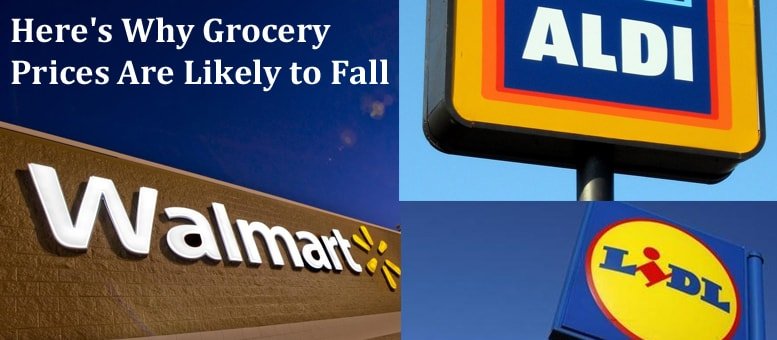And will probably continue to fall
May, 2017 – Anyone who shops at a large supermarket may have noticed a price war that has been brewing among major chains which has been bringing the cost of food down. The primary reason is due to an effort by Walmart to react to, and ready itself for, stiff competition from Aldi and Lidl, a pair of German-based discount grocers.
In February of 2017 Walmart began running a new price comparison test in 1,200 of its U.S. stores focusing on grocery prices. Walmart is the country’s largest grocer and it is a business line that accounts for 56% of the company’s revenue. At the same time the big retailer started squeezing packaged goods suppliers in a bid to close a pricing gap with German-based discount grocery chain Aldi.
Walmart has worked feverishly to keep its grocery prices below that of Aldi’s and has cut prices on some products by as much as 30% over the past few months. Aldi and Lidl run no-frills stores with limited product assortment. They sell lots of private label brands at discount to the competition. Currently, Aldi is a small player in the U.S. with only about 1.5% of the market however it is growing at 15 percent a year. Walmart’s grocery business is growing at about 2% a year. Lidl will open its first 20 U.S. stores in June, 2017 with plans to open 80 more stores by the end of 2018. It should have more than 330 U.S. stores by 2020. Most of the launch stores are in close proximity to Walmart-owned stores.
Don’t be confused – Walmart remains a retail Goliath as it currently controls about 22 percent of the total U.S. grocery market and is unlikely to lose its place as the country’s largest grocer to the likes of Aldi or Lidl. But executives at Walmart know that the German discounters have successfully upended the UK market by undercutting large players like Tesco and Walmart’s own subsidiary there, Asda.
The Ripple Effect
Aldi has been in the US market for several years and has found a way to successfully undercut Walmart on grocery prices. Lidl has announced that it is eager to capture US market share at all costs. The company claims that its products would be up to 50% cheaper than competitors which will include not only Walmart but Kroger, Albertsons and Publix along with a slew of midsized regional players.
The Lidl strategy is to allow for huge losses by massively undercutting prices in hopes of capturing market share from established retailers. Lidl is no novice to the grocery business and it knows how to penetrate markets as it runs 10,000 stores in 27 countries.
Some analysts fear that the fierce competition in the sector could lead to a deflationary shock that would ripple across the entire U.S. grocery store supply-chain. Falling prices may lead to even thinner margins in an industry where the average supermarket’s profit margin ranges from 1 to 2 percent. This would most likely squeeze out a host of smaller players and cause even more industry consolidation.
The Consumer Wins?
Given the rise of private label store brands (Lidl sales are 90% store brands) many food companies feel they have no choice but to collaborate with Walmart’s price cutting strategy. Another dynamic that threatens the traditional grocery business is the still-unknown factor of how Amazon will affect their businesses. All these factors, combined with the rise of the aggressive discount grocer model, make it likely that the U.S. consumer is about to be the big winner as prices for groceries seem poised to fall even more.
A warning though, if the price wars cause too many casualties then the grocery market may end up with just a few large survivors who will come back to the customer and seek repayment for what some believe may be nothing but a period of ‘subsidization’ in the grocery industry.

